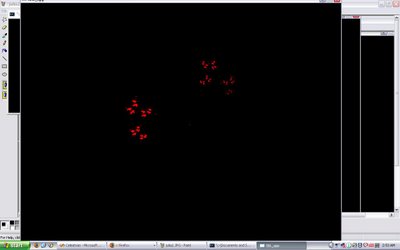
Randomness. What is it and who needs it? I think life would be more fun if it made sense! Everything should happen exactly as it is supposed to, no excuses. If I call heads, heads it is.
How droll.
sigh. Now I am bored. I wish things would surprise me for once...
But, even though I am bored, I want to be able to have some sense of what is
supposed to happen so I can sleep at night. Therefore, I am going to say that the universe is
deterministic. I don't believe in luck, and everything is just falling.
I havent ever read up on quantum mechanics either...
Once we get into the realm of the really really, quite ludicrously small things, it becomes hard to maintain that point of view. One of the most classic examples of a random number is the flip of a coin, and this method of producing a random number relies entirely on quantum mechanics.
See, when the coin is fired up into the air, it rotates around, reaches its pinnacle, then plummets downward for a crazy impact. The moment of that impact is completely unpredictable, and here is why: The deflection of the coin is based on the collision of opposing negative forces of what are essentially
electron probability clouds. Because the electrons of the floor and the electrons of the coin are moving at nearly the speed of light, the exact position of the forces that determine the angle and force of deflection will be unique and unpredictable (two important properties of randomness). Furthermore, the coin flip depends on human factors like the velocity and direction of the flip, or possibly sweaty hands, and cannot be accurately described using mathematics.
Now lets consider how we generate a random number on a computer. We use a recursive equation that will spit out a stream of seemingly unrelated numbers when initialized with a seed. The trick is that the seed must be a random number for the sequence to be random*. What we have then is a
random number generator that requires a primer of an initial random number to get it rolling. Seems a bit silly, really... if we can already generate a random number, then why would we be trying to generate a random number?
The answer is that there is one pretty decent random number that we always have available, and it is the same mechanism that drives the randomness of the coin flip. The heart of the coin flip was the uniqueness of that particular moment when the coin hits the ground. That freezeframe in time was the random engine. Indeed, that spontaneous instant when you decide to let go of the coin is the force behind the randomness. In computers, it is the exact instant in which the random number generator is initialized that determines the sequence. So the force behind the random number is again, in a way, the spontaneity of your decision to run the program.
In the end, we use our own absurd brains and weird fuzzy logic to break free of the order of a computer to find the chaos that is required to get a truly random number. *Granted, it can be argued that the numbers that computers generate are not random in the same sense as the flip of a coin, but is the flip of a coin random in the same way as rock-paper-scissors?
In rock-paper-scissors, again the random mechanism is slighly different but it returns to the spontaneous instant. There is still a 50% chance of either outcome, but it is based entirely on the whimsical fancy of 2 humans; not on literal quantum collisions but on the interactions of quantum-level software encoded in the brain's neural network.
So what is random? it seems like every random event has its own flavor. I mentioned three examples of "random numbers." Each is determined by a different mechanism, yet each seems valid in different ways, and that is the magic of the random.
I say randomness IS the spontaneousness itself. Its the shifting passions and tides of reality and the urges that make us yell out "rock!" or double click on a program right
now instead of
now. Maybe that is why a computer will never understand a true random number. They need human beings and our absurd nature to supply that extra kick of random flavor.
mmmmm.... sweet random flavor. Life is good when you don't know what hit you.
Floating like a Flea
I live only where I don't
You cannot find me
-random haiku














